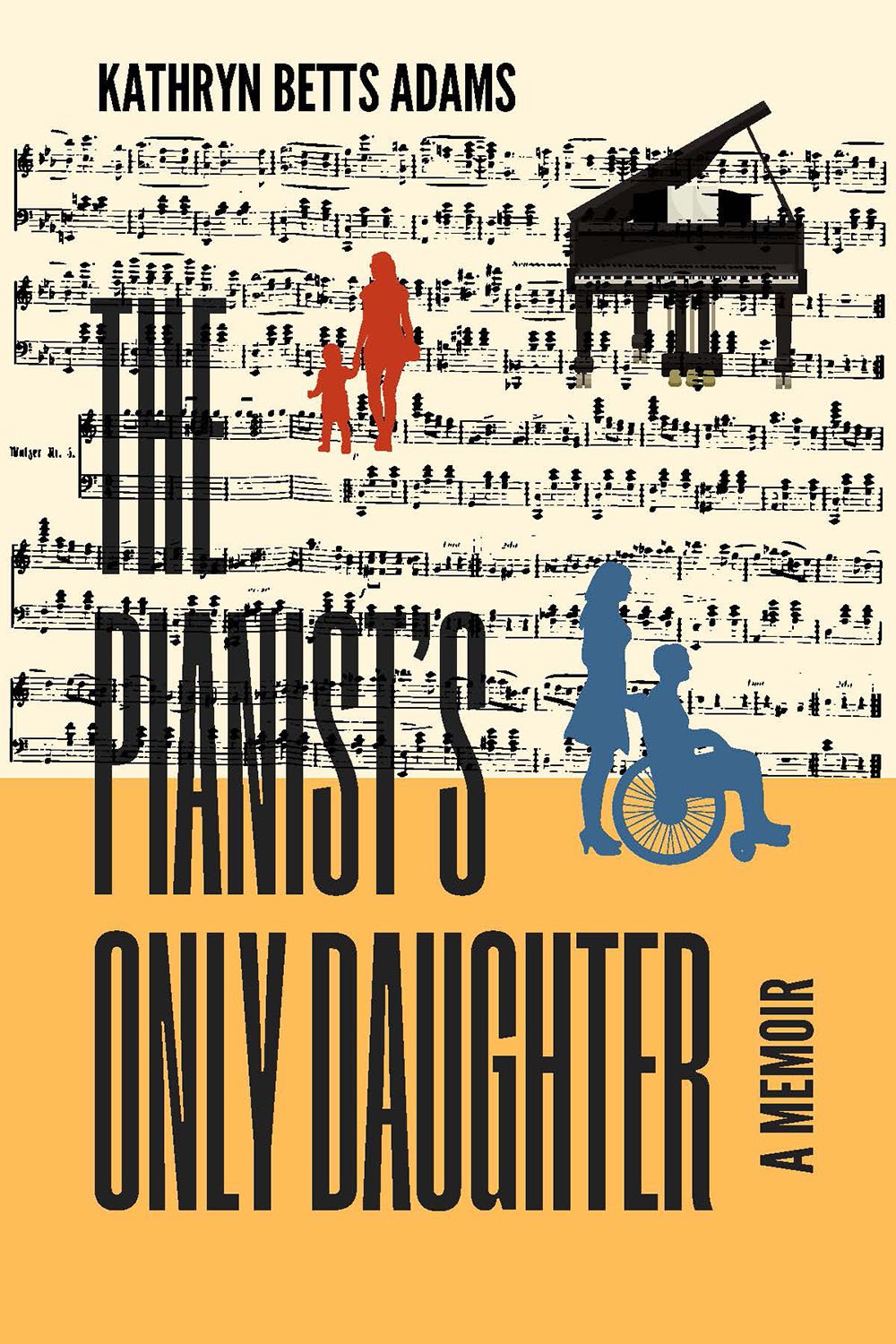The Pianist’s Only Daughter
Katy Designed the Cover Herself
An intimate debut
Katy had me by the third page when she wrote, “. . . when I peer at myself in the bathroom mirror, I hold the skin folds of my chin taut against my earlobes, erasing the years with one small motion.” This precious moment sets the tone for a narrative that is revealing, honest, and beautifully told. Interspersed with original poetry, the prose speaks of a daughter’s deep love for her father and the challenges she faced caring for a difficult man. Katy’s father had a uniquely challenging personality. To me, he came across as self-centered and ungrateful. Sometimes, I wanted to haul off and slap him. Sometimes, Katy did too. But she resisted the impulse, steadfast in her determination to give him the best care she possibly could; even to the extent of moving him in with herself and her husband when they began a new life in California. This can’t have been easy and, Katy and her husband relocated they found a separate apartment for her father. Given his personality, it was no surprise that he resented the new arrangement. It’s a cautionary story that I’ve heard before—the sandwich generation moves an aged parent in with them only to find that the parent feels cheated when the adult children relocate.
The narrative is peppered with beautiful moments revealing the depth of a daughter’s love, which transcends difficulty, personality, history, and distance. Momentos and family photos enrich the book and its author comes across as brave, thoughtful, and modest to a fault. The story is fascinating on a personal level, even as it illustrates America’s appalling failure to provide a rational system of care for older adults.
Kirkus described the book as, “an enthralling account that traces the highs and lows of a family dealing with aging.” Here’s their review.
Full disclosure: Katy and I were acquainted when we both labored in the academic trenches of gerontological social work. After reading her fascinating memoir, I feel I know and admire her even more.
You can find the book on Amazon or at your favorite bookstore.
Katy and I had a delightful interview about what went into her new memoir. Keep reading for a slightly edited version of our conversations via email and zoom.
The author, herself
Meet Katy Betts Adams
Amanda: Your memoir is such a good read! How did the process of writing go for you? Did you discover new memories?
Katy: Thank you!! I worked on the memoir for about 3.5 years. In the beginning, I was simply writing a couple of essays about unfortunate incidents we’d had with the eldercare system, like when the hospital had my mom transferred to a nursing home on a Saturday night without any appropriate services in place yet. Then the pandemic started, and I found that Westport Writers would be offering workshop classes over Zoom, and from then on, I attended weekly workshop sessions and kept writing, Eventually, I realized I was working on a book and I went back to my childhood parts. Since mostly I kept to chronological order, I didn’t really use an outline. The structure kind of came together the more I wrote.
I did discover new memories, absolutely. It’s not unlike attending psychotherapy – you write and things come up, whether while writing, or when driving or going to sleep at night. And about drafts, well there were MANY!
When we met, Katy added that she likes to work in the great room at home, especially when she has the place to herself. Her writing began with journaling, a practice she thorough enjoyed.
Amanda: What led you to decide to self-publish your memoir? How did that process go? Do you have any advice for others going in this direction?
Katy: I ended up with self-publishing after querying a number of literary agents and independent publishers. A couple kindly said they’d like to help but memoirs are not a huge seller unless your book is about someone famous or a very sensational story. I believed in my story, so I decided to go ahead and produce the book with the help of Amazon’s Kindle Direct publishing and I think it has turned out nicely. And by the way, I made the cover myself with a little help from my son and the program “Canva” and I’ve had many compliments on it.
Amanda: Some of the names in your book were changed – Sharon and Thomas, as I recall. What brought you to this decision? Were any other names changed?
Katy: I decided early on to change the name of my father’s late-life lady friend, and also my brother’s girlfriend, but I also thought there might be good reason to use pseudonyms for my brother and his mom, my former step-mother, just to guard a little more of their privacy.
I asked how Katy’s family had reacted to the book. She said her cousins are just reading it now. Her step-mom loves it. She didn’t think Katy even needed to use a pseudonym for her. Finally, Katy sent a link to her brother but is not sure whether he’s read the book.
Amanda: In your acknowledgements, you mention the Westport Writers Workshop as a source of encouragement and feedback. How did you find them? How did your meetings work?
Katy: Westport Writers’ Workshop is in Westport, Connecticut, about an hour and twenty minutes away from where I live in the Hartford area, but they did offer some in-person courses in my area back in 2016-17, and I took one then. I continued to get their emails but figured they were out of reach once they stopped offering their Hartford area courses. However, as we all know, the pandemic changed everything and they started to offer Zoom courses. I took several different courses from different instructors, but I mostly stuck with Advanced Memoir with Christine Pakkala, whom I thank in the Acknowledgments. She was very encouraging and helpful and served as one of two editors of the manuscript.
Amanda: I have known you as a social work professor and am delighted to learn about your background. How did your social work training and experience influence your caregiving? Did it help shape the memoir?
Katy: I started the essays for my book primarily from the perspective of “a gero-social worker/ academic experiences what it’s like to be an eldercare family member (hint: not great).” Then I became more and more convinced to integrate the personal and the professional in myself into the story. I had really hoped to do a better job helping my parents when their chronic illness (my mother had Parkinson’s disease) and aging kind of caught up with them, since I had a lot of knowledge and experience. But as the book describes, it still wasn’t easy, both because of old family dynamics and because the services available are not always what we need or want them to be.
Katy later said at times she felt like as a professional she “should have known better.” She was surprised by the many flaws she discovered in her encounters with the eldercare system.
Amanda: Did you decide to leave some stories out?
Katy: I definitely left some of myself out. I focused less on my life story and more on my parents and my story as it connected to them. There is probably another book to write someday. I’m sure I left out how I yelled at my mom when I was a teen and young adult, and tended to blame her for things that weren’t her fault, since at that time she was “safe” to be mad at and my father wasn’t.
Amanda: Were there any villains in this piece? Why or why not?
Katy does not see anyone in her memoir as a villain, even her sometimes-very-difficult father. She said, Nope. No villains. At the start, the reader learns that my (half-) brother is out of touch with our dad and that I’m handling his care and support alone, but he’s not a villain. He’s a human who had been rather over-controlled by our dad. But neither is my father a villain, although he acted out and tended to be self-absorbed at times during his life, to the detriment of my mother and me, and my brother and his mom.
Amanda: I love the title of your book. It has such strong poetic resonance, The Pianist’s Only Daughter. How did you find it? Or did it find you?
Katy: Thank you! I love the title, too. I had been focusing on the idea that I was the only daughter, the only responsible one for my parents. But eventually, as I finished the last part of the book that’s describes my father’s final years, I decided that the major narrative of the whole story was my relationship with him and how it came full circle. So then the title just presented itself to me. It was an “Aha” moment.
Amanda: Your closing image of painful memories sinking to the bottom while happier ones bob up is just lovely. Does this mirror your experience?
Katy: I certainly wanted it to be true of my experience. Time definitely helps. But I did find that I just had to move past the regrets and guilt and mildly traumatic memories about their aging journeys, because I needed to try to be fully present in the rest of my own life after they passed.
Katy said she is moving past the trauma. For her, the greatest difficulty comes from blaming herself for her mother’s hip fracture. She added that many of us tend to blame ourselves for our loved one’s suffering, even when, as she put it, it’s just the nature of aging.
Amanda: What’s next? More books? More social work? More fun?
Katy: More fun, with our first grandchild who is now a year old. And I continue to collaborate on academic research papers, and I write essays about aging that I post on Medium.com and my own website. And maybe another book will emerge, and meanwhile, I’m hoping to talk more about this book as people ask me to!!
Looking for more of Katy’s work? Check out the light-hearted podcast she and her friend Jenny Anderson put together on Spotify. It’s called “Two Third-agers” The one on forgetting and dementia is especially popular. You’ll also find links to the podcast and more on her website.


